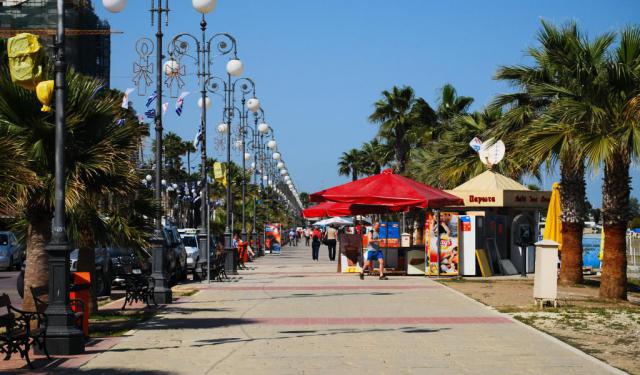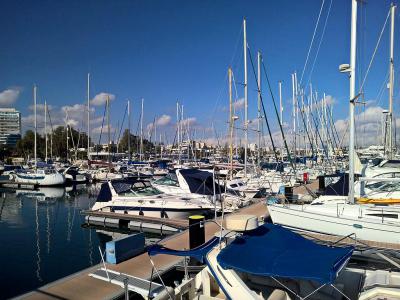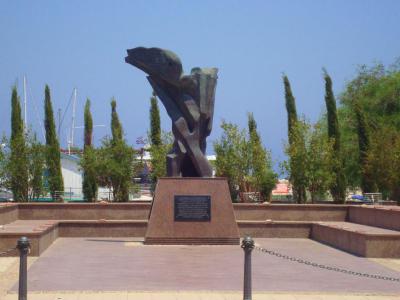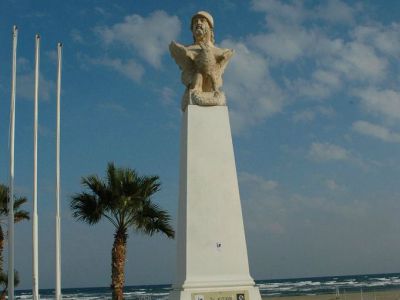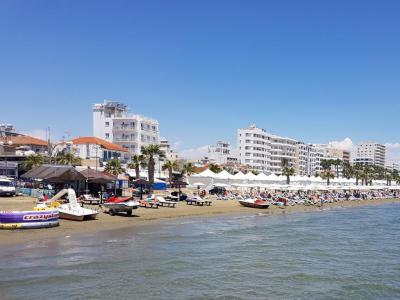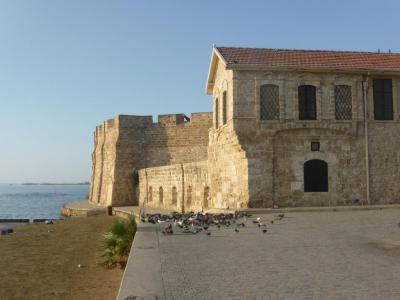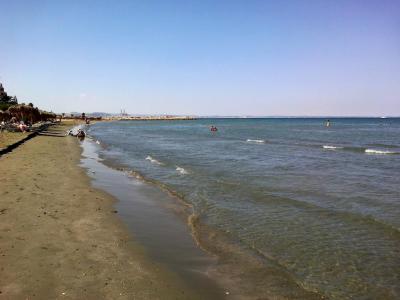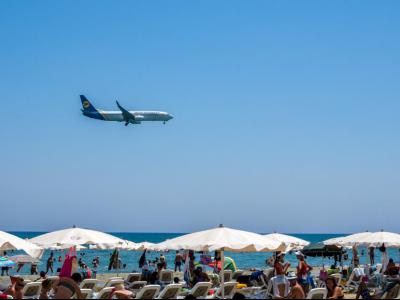Seaside Promenade Walk (Self Guided), Larnaca
Throughout its multi-thousand-year history, Larnaca has "moved" several times, not only along the sea, but also inland and back, towards the shore. Today, the promenade of Larnaca is the very heart of the city, stretching for three kilometers.
For most tourists Larnaca is just the place where the Airport is located and the first thing they see upon arrival. During the day, herds of tourists and locals come here for a walk, to swim in the sea, or to take memorable pictures, meet friends, or dine with their families. In the evening, the area is just as lively and fun to be in, thanks to the abundance of cafes, bars and shops of all stripes, offering a variety of products and different types of food.
The Larnaca promenade is busy, even in low season, and, given the presence of a motorway, also quite noisy.
The promenade itself is divided in three parts: Finikoudes, Piale Pasha and Mackenzie. The former, situated between the Larnaca Castle and the Seaport, is the most famous and lined with palm trees on both sides (hence the name, meaning “dates”). Right in front of it is the eponymous beach, known for its calm, shallow waters and volcanic sand.
The medieval Castle (Fort), built in 1625, presumably under the Turkish rule, located in the northern part of the promenade, and Larnaca Marina, in the southern part, are the two major landmarks easily reachable from here.
Other notable beaches – such as Kastela and Mackenzie – lie behind the fishing port and next to the Airport, respectively. The latter beach is particularly popular with those keen on planes – flying directly over your head.
For a more detailed acquaintance with the delights of Larnaca's Seaside, take this self-guided walking tour.
For most tourists Larnaca is just the place where the Airport is located and the first thing they see upon arrival. During the day, herds of tourists and locals come here for a walk, to swim in the sea, or to take memorable pictures, meet friends, or dine with their families. In the evening, the area is just as lively and fun to be in, thanks to the abundance of cafes, bars and shops of all stripes, offering a variety of products and different types of food.
The Larnaca promenade is busy, even in low season, and, given the presence of a motorway, also quite noisy.
The promenade itself is divided in three parts: Finikoudes, Piale Pasha and Mackenzie. The former, situated between the Larnaca Castle and the Seaport, is the most famous and lined with palm trees on both sides (hence the name, meaning “dates”). Right in front of it is the eponymous beach, known for its calm, shallow waters and volcanic sand.
The medieval Castle (Fort), built in 1625, presumably under the Turkish rule, located in the northern part of the promenade, and Larnaca Marina, in the southern part, are the two major landmarks easily reachable from here.
Other notable beaches – such as Kastela and Mackenzie – lie behind the fishing port and next to the Airport, respectively. The latter beach is particularly popular with those keen on planes – flying directly over your head.
For a more detailed acquaintance with the delights of Larnaca's Seaside, take this self-guided walking tour.
How it works: Download the app "GPSmyCity: Walks in 1K+ Cities" from Apple App Store or Google Play Store to your mobile phone or tablet. The app turns your mobile device into a personal tour guide and its built-in GPS navigation functions guide you from one tour stop to next. The app works offline, so no data plan is needed when traveling abroad.
Seaside Promenade Walk Map
Guide Name: Seaside Promenade Walk
Guide Location: Cyprus » Larnaca (See other walking tours in Larnaca)
Guide Type: Self-guided Walking Tour (Sightseeing)
# of Attractions: 7
Tour Duration: 2 Hour(s)
Travel Distance: 3.0 Km or 1.9 Miles
Author: AudreyB
Sight(s) Featured in This Guide:
Guide Location: Cyprus » Larnaca (See other walking tours in Larnaca)
Guide Type: Self-guided Walking Tour (Sightseeing)
# of Attractions: 7
Tour Duration: 2 Hour(s)
Travel Distance: 3.0 Km or 1.9 Miles
Author: AudreyB
Sight(s) Featured in This Guide:
- Larnaca Marina
- Armenian Genocide Memorial in Larnaca
- Bust of General Kimon
- Finikoudes Beach
- Larnaca Fort and Medieval Museum
- Kastela Beach
- Mackenzie Beach
1) Larnaca Marina (must see)
Larnaca Marina is a marina and mooring facility located in Larnaca Bay. The marina offers mooring for up to 450 vessels. Those who love watching boats come in and out of the bay will enjoy a walk around the marina.
Visitors will find fully paved pedestrian walkways. Pedestrians are welcome to walk to the end of the pier, find a seat and enjoy the relaxing view. They can also visit the nautical themed shop on the premises for a fun souvenir.
Those who want to test the water can book boating trips from the marina. Fishing is also allowed at the end of the pier.
A plan is underway to greatly expand the marina and the surrounding area. Included in the plan is space for more than 200 more vessels, a yacht club, a retail park, residential areas and even a private island. It is expected that this development will more than double the size of the marina and port.
Visitors will find fully paved pedestrian walkways. Pedestrians are welcome to walk to the end of the pier, find a seat and enjoy the relaxing view. They can also visit the nautical themed shop on the premises for a fun souvenir.
Those who want to test the water can book boating trips from the marina. Fishing is also allowed at the end of the pier.
A plan is underway to greatly expand the marina and the surrounding area. Included in the plan is space for more than 200 more vessels, a yacht club, a retail park, residential areas and even a private island. It is expected that this development will more than double the size of the marina and port.
2) Armenian Genocide Memorial in Larnaca
The Armenian Genocide Memorial in Larnaca is dedicated to both those who died and who survived in the Armenian genocide that took place in the Ottoman Empire during World War I. During their invasion of Russian and Persian territory in 1914, Ottoman paramilitaries massacred local Armenians.
The monument rests on the spot where Armenians arrived at cyprus as they fled the genocide.
The memorial was envisioned by Bedros Kalaydjian, a representative of the Armenian community in Cyprus. It was carried out as a joint effort between the governments of Cyprus and Armenia. The memorial was designed by architects Angelos Demetriou and Michael Thrassou. Work was completed on the bronze monument in 2008.
The Armenian Genocide Memorial in Larnaca features a bronze monument that is surrounded by rows of vegetation. Four granite plaques in Armenian, English, Greek and Turkish sit at its base. The sculpture work was designed by artist Georgios Kalakallas.
Due to the memorial's location on the seafront, the monument is close to many other places of interest in Larnaca. Tourists can easily reach Finikoudes Beach, Larnaca Castle and the historic Church of St. Lazarus among many other notable spots.
The monument rests on the spot where Armenians arrived at cyprus as they fled the genocide.
The memorial was envisioned by Bedros Kalaydjian, a representative of the Armenian community in Cyprus. It was carried out as a joint effort between the governments of Cyprus and Armenia. The memorial was designed by architects Angelos Demetriou and Michael Thrassou. Work was completed on the bronze monument in 2008.
The Armenian Genocide Memorial in Larnaca features a bronze monument that is surrounded by rows of vegetation. Four granite plaques in Armenian, English, Greek and Turkish sit at its base. The sculpture work was designed by artist Georgios Kalakallas.
Due to the memorial's location on the seafront, the monument is close to many other places of interest in Larnaca. Tourists can easily reach Finikoudes Beach, Larnaca Castle and the historic Church of St. Lazarus among many other notable spots.
3) Bust of General Kimon
The Bust of General Kimon rest on a walkway in the center of the Finikoudes Beach promenade. The bust was designed by sculptor George Alexandropoulos in 1927. It is made of pentelic marble and concrete. The image of General Kimon is based off of an engraved figure on a stone ring.
Kimon, born in 510 BC, was the general who led the Greek army against the Persian army in the 490 BC Battle of Marathon. He sailed to Cyprus with the goal of expelling all Persians. Along with his army, General Kimon freed the kingdom of Marion and replaced the Phoenician king with a Greek king.
Kimon's died in 449 BC from the plague while battles were still raging. His soldiers continued to fight and win the Battle of Salamina. The phrase "even in death he was victorious" was first spoken about Kimon.
Visitors can see the Bust of General Kimon at any time during the night or day. While best viewed during daylight, lights on the promenade allow for evening strolls that are safe and serene.
Kimon, born in 510 BC, was the general who led the Greek army against the Persian army in the 490 BC Battle of Marathon. He sailed to Cyprus with the goal of expelling all Persians. Along with his army, General Kimon freed the kingdom of Marion and replaced the Phoenician king with a Greek king.
Kimon's died in 449 BC from the plague while battles were still raging. His soldiers continued to fight and win the Battle of Salamina. The phrase "even in death he was victorious" was first spoken about Kimon.
Visitors can see the Bust of General Kimon at any time during the night or day. While best viewed during daylight, lights on the promenade allow for evening strolls that are safe and serene.
4) Finikoudes Beach (must see)
Larnaca has a number of beaches that are worth visiting. The primary beach of the city is Finikoudes Beach, which is large, easy to reach and offers access to a number of important places. It is not just the most famous beach in Larnaca but is arguably the most famous in southern Cyprus.
The beach was named after the palm trees planted on the site in 1922. It is a grey sand beach with ample room for the many tourists that flock to the sand during peak season. The water remains mostly calm throughout the year but a lifeguard remains onsite in the summer months for added protection.
Tourists to Finikoudes Beach can rent sunbeds and umbrellas if they want to stay on the beach for a significant amount of time. They will also see a large number of places to eat and shop. An arcade is nearby as is the municipal amphitheatre. Visitors will also find the Bust of General Kimon and the Armenian Genocide Memorial on the beach's promenade.
Athenon Avenue runs parallel to Finikoudes Beach. The city center is located just on the other side of this road, which makes reaching the beach an easy endeavor.
The beach was named after the palm trees planted on the site in 1922. It is a grey sand beach with ample room for the many tourists that flock to the sand during peak season. The water remains mostly calm throughout the year but a lifeguard remains onsite in the summer months for added protection.
Tourists to Finikoudes Beach can rent sunbeds and umbrellas if they want to stay on the beach for a significant amount of time. They will also see a large number of places to eat and shop. An arcade is nearby as is the municipal amphitheatre. Visitors will also find the Bust of General Kimon and the Armenian Genocide Memorial on the beach's promenade.
Athenon Avenue runs parallel to Finikoudes Beach. The city center is located just on the other side of this road, which makes reaching the beach an easy endeavor.
5) Larnaca Fort and Medieval Museum (must see)
The Larnaca Fort and Medieval Museum is arguably the top tourist attraction in Larnaca. It was built by Lusignan King Iacov I in the 14th century on the grounds of a previously built 11th century fortress. The castle was destroyed, and then rebuilt from the ground up in 1625.
Once the castle was no longer used as fortification it was utilized as a police station and prison while under British rule. This continued through the mid-20th century. It served as the Larnaca District Museum in 1948, and then took its current role as a provincial museum in 1969.
The Medieval Museum is located on the second floor of the fort at the end of the Finikoudes. The three-room collection offers exhibits and artifacts from 4th through the 19th centuries. Among the exhibits, visitors will find Byzantine wall paintings, Medieval glazed pottery, Venetian helmets and swords and Ottoman cooking utensils.
The castle courtyard is now used as an open-air theatre during the summer season. Visitors to the courtyard will also see a collection of artillery that dates to the Middle Ages. A square tower sits on the east side of the castle under which there are tombstones dating from the 15th to the 18th centuries.
Larnaca Fort and Medieval Museum are open throughout the year. Winter hours are 8 AM through 5 PM while summer hours are 8 AM to 7:30 PM. On Saturdays and Sundays during winter and summer seasons the hours are abbreviated to 9:30 AM through 5 PM.
Once the castle was no longer used as fortification it was utilized as a police station and prison while under British rule. This continued through the mid-20th century. It served as the Larnaca District Museum in 1948, and then took its current role as a provincial museum in 1969.
The Medieval Museum is located on the second floor of the fort at the end of the Finikoudes. The three-room collection offers exhibits and artifacts from 4th through the 19th centuries. Among the exhibits, visitors will find Byzantine wall paintings, Medieval glazed pottery, Venetian helmets and swords and Ottoman cooking utensils.
The castle courtyard is now used as an open-air theatre during the summer season. Visitors to the courtyard will also see a collection of artillery that dates to the Middle Ages. A square tower sits on the east side of the castle under which there are tombstones dating from the 15th to the 18th centuries.
Larnaca Fort and Medieval Museum are open throughout the year. Winter hours are 8 AM through 5 PM while summer hours are 8 AM to 7:30 PM. On Saturdays and Sundays during winter and summer seasons the hours are abbreviated to 9:30 AM through 5 PM.
6) Kastela Beach
Kastela Beach is a small beach in Larnaca located south of the larger and more heavily trafficked Finikoudes Beach. Kastela Beach is popular with families because of its soft, grey sand and children's playground.
The beach has typical facilities that are handy for those who wish to spend the day in the sun or simply need a break. Visitors will find toilets, changing rooms and showers. Sunbeds, umbrellas and luxury double loungers are available for rent. There are also numerous restaurants and cafes within a few steps of the beach.
Lifeguards are posted on Kastela Beach during the peak summer season from June through October. The water remains calm enough for wading and swimming even when lifeguards are not present. Fishing is also a very popular activity on Kastela Beach.
Kastela Beach was awarded a blue flag for having eco-friendly marina practices. It is also known for having some of the cleanest water in Europe.
The beach has typical facilities that are handy for those who wish to spend the day in the sun or simply need a break. Visitors will find toilets, changing rooms and showers. Sunbeds, umbrellas and luxury double loungers are available for rent. There are also numerous restaurants and cafes within a few steps of the beach.
Lifeguards are posted on Kastela Beach during the peak summer season from June through October. The water remains calm enough for wading and swimming even when lifeguards are not present. Fishing is also a very popular activity on Kastela Beach.
Kastela Beach was awarded a blue flag for having eco-friendly marina practices. It is also known for having some of the cleanest water in Europe.
7) Mackenzie Beach (must see)
Mackenzie Beach is a must-see beach in Larnaca. The sandy beach has palm trees that offer natural shade. It is a flat beach, which makes both lounging and walking along the beach easy. Calm, shallow waters offer safe wading even for young children. Mackenzie Beach is a favorite for local families who want to relax by the sea.
Mackenzie Beach also offers numerous water sports and activities. Visitors can rent jet skis, go water skiing, try windsurfing or even rent a speed boat. Diving is a very popular activity at Mackenzie Beach because the Zenobia Wreck Diving Site is nearby. The Zenobia Wreck is 172 meters long (564 feet). It is often said to be one of the best dive sites in the world.
Like many beaches in Cyprus, Mackenzie Beach has blue flag status. This is awarded to a beach that strives to keep sand and water clean while also offering a safe environment.
The promenade along Mackenzie Beach provides access to a large number of cafes and bars. Ice cream, espresso and even mixed drinks are available without leaving the sand. Shaded outdoor dining on wooden flooring is also widely available. The beach area becomes even more active at night when bars and nightclubs open.
Mackenzie Beach was named after a man named McKenzie who moved to Larnaca from Scotland after World War II. He opened a restaurant and bar that he named after himself. The restaurant proved so popular that locals began referring to the beach with the restaurant's name.
Mackenzie Beach also offers numerous water sports and activities. Visitors can rent jet skis, go water skiing, try windsurfing or even rent a speed boat. Diving is a very popular activity at Mackenzie Beach because the Zenobia Wreck Diving Site is nearby. The Zenobia Wreck is 172 meters long (564 feet). It is often said to be one of the best dive sites in the world.
Like many beaches in Cyprus, Mackenzie Beach has blue flag status. This is awarded to a beach that strives to keep sand and water clean while also offering a safe environment.
The promenade along Mackenzie Beach provides access to a large number of cafes and bars. Ice cream, espresso and even mixed drinks are available without leaving the sand. Shaded outdoor dining on wooden flooring is also widely available. The beach area becomes even more active at night when bars and nightclubs open.
Mackenzie Beach was named after a man named McKenzie who moved to Larnaca from Scotland after World War II. He opened a restaurant and bar that he named after himself. The restaurant proved so popular that locals began referring to the beach with the restaurant's name.
Walking Tours in Larnaca, Cyprus
Create Your Own Walk in Larnaca
Creating your own self-guided walk in Larnaca is easy and fun. Choose the city attractions that you want to see and a walk route map will be created just for you. You can even set your hotel as the start point of the walk.
Larnaca Introduction Walking Tour
Larnaca is the third-largest city in Cyprus. It was once a city-kingdom known as Kitoin. Though Kition was established in the 13th century BCE, the Phoenicians rebuilt the area around 1000 BCE. Some of the remains from this time, like cyclopean walls and temples, can still be seen today.
The modern name, Larnaca, is derived from the Greek word "larnax" due to the numerous burial sites... view more
Tour Duration: 1 Hour(s)
Travel Distance: 1.8 Km or 1.1 Miles
The modern name, Larnaca, is derived from the Greek word "larnax" due to the numerous burial sites... view more
Tour Duration: 1 Hour(s)
Travel Distance: 1.8 Km or 1.1 Miles
The Most Popular Cities
/ view all
